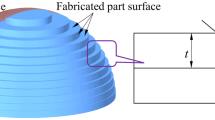Abstract
It stands to reason that the additive manufacturing build orientation for the material extrusion process affects the support material requirements, processing time, surface finish, etc. This paper aims to study the influence of the build orientation on the optimal process parameter settings (bead width, overlap, and raster angle), the amount, and location of unwanted voids. This research shows that there are limited optimal solution alternatives over the large solution space explored. The layer by layer process parameters are not selected independently. Knowledge of a void location in one layer is utilized to select a process parameter set for the next layer, preventing void regions from being stacked in 3D, and avoiding creating an internal chimney. Material extrusion processes, with a wide selection of nozzle sizes (0.4 mm to 21 mm), are considered suitable candidates for this solution. To carry out this study, a literature review was performed to understand the influence of the build parameters. Then, an analysis of valid parameter settings to be targeted was performed for a commercial system. The mathematical model is established based on the component geometry and the available build options for a given machine-material configuration. A C++ program has been developed to select a set of standards (available) toolpath parameters to determine the optimal process variables. Case studies are presented to show the merits of this approach. The influence of the orientation on the optimal process parameters is illustrated as well as its impact on voids. As expected, it is statistically shown that the amount and location of the voids depends on the build orientation. The optimal solution for the void minimization may be suboptimal for other criteria such as support material usage; consequently, a comprehensive multi-objective optimization heuristic algorithm needs to be developed. The processing time is long and is unacceptable for industrial applications. This outcome also needs to be addressed.
Similar content being viewed by others
References
Proto3000 (2016) Fortus400mc. https://proto3000.com/assets/uploads/PDFs/Fortus380450_2015A.pdf. Accessed 26 Feb 2018
Schmidt A (2017), Self-supporting angles in large scale additive manufacturing. AES Originals, Large Scale 3D Printing. http://www.additiveeng.com/self-supporting-angles-in-large-scale-additive-manufacturing/. Accessed 26 Feb 2018
Cosine Additive (2017) Medium area additive manufacturing (MAAM) handout. https://static1.squarespace.com/static/55627b1be4b020bb00b2d516/t/5734ec36f699bb435295f4b7/1463086144705/CosineAdditive_Handout_AM1Specs-web.pdf. Accessed 3 May 2017
Composites Manufacturing (2014) Pros and cons of additive manufacturing. http://compositesmanufacturingmagazine.com/2014/10/pros-cons-additive-manufacturing/2/. Accessed 2016
Kishore V, Ajinjeru C, Nycz A, Post B, Lindahl J, Kunc V, Duty C (2017) Infrared preheating to improve interlayer strength of big area additive manufacturing (BAAM) components. Addit Manuf J 14:7–12
Cincinnati (2017) SAAM specifications. https://www.e-ci.com/saam-specifications/. Accessed 1 May 2017
W. Associates (2014) Wohlers report—3D printing and additive manufacturing state of the industry. Annual Worldwide Progress Report
Eiliat H, Urbanic JR (2018) Visualizing, analyzing, and managing voids in the material extrusion process. J Adv Manuf Technol
Ahn S-H, Montero M, Odell D, Roundy S, Wright PK (2002) Anisotropic material properties of fused deposition modeling ABS. Rapid Prototyp J 8(4):248–257
Onwubolu GC, Rayegani F (2014) Characterization and optimization of mechanical properties of ABS parts manufactured by the fused deposition modelling process. Hindawi Publishing Corporation. Int J Manuf Eng 2014:1–13
Rayegani F, Onwubolu GC (2014) Fused deposition modelling (FDM) process parameter prediction and optimization using group method for data handling (GMDH) and differential evolution (DE). Int J Adv Manuf Technol 73(1):509–519
Sood AK, Chaturvedi V, Datta S, Mahapatra SS (2011) Optimization of process parameters in fused deposition modeling using weighted principal component analysis. J Adv Manuf Syst 10(2):241–259
Vijayaraghavan V, Garg A, Lam JSL, Panda B, Mahapatra SS (2015) Process characterisation of 3D-printed FDM components using improved evolutionary computational approach. Int J Adv Manuf Technol 78(5–8):781–793
Vidakis N, Petousis M, Konstantinos S, Vairis A, Athina M, Manolis A (2015) Experimental determination of fused deposition modelling parts compressive strength. 9th International Conference New Horizons in Industry, Business and Education at Skiathos
Lee CS, Kim SG, Kim HJ, Ahn SH (2007) Measurement of anisotropic compressive strength of rapid prototyping parts. J Mater Process Technol 187-188:627–630
Stucker B, Rosen DW, Gibson I (2010) Additive manufacturing technologies. Springer, ISBN: 978-1-4419-1119-32010
Pandey PM, Reddy MV, Dhande SG (2003) Real time adaptive slicing for fused deposition modelling. Int J Mach Tool Manu 43(1):61–71
Ledalla SRK, Tirupathi B, SriramV (2016) Performance evaluation of various STL file mesh refining algorithms applied for FDM-RP process. J Inst Eng https://doi.org/10.1007/s40032-016-0303-4, 99, 339, 346
Stratasys (2014) FDM Machine. http://www.stratasys.com/. Accessed 12 Jan 2017
Kyle Stetz (2009) Makerbot Vs. Dimension SST 1200es. https://kylestetzrp.wordpress.com/. Accessed 26 Feb 2018
All 3D (2017). Best 3D printing software tools. https://all3dp.com/1/best-free-3d-printing-software-3d-printer-program/. Accessed August 2017
Thompson A, Maskery I, Leach RK (2016) X-ray computed tomography for additive manufacturing: a review. Meas Sci Technol 27(7):1–17
Acknowledgments
The authors would like to thank CAMufacturing Solutions Inc. (especially Bob Hedrick) for their assistance with the C++ programming.
Funding
This research is funded by the Natural Sciences and Engineering Research Council of Canada through the Discovery Grant.
Author information
Authors and Affiliations
Corresponding author
Rights and permissions
About this article
Cite this article
Eiliat, H., Urbanic, J. Determining the relationships between the build orientation, process parameters and voids in additive manufacturing material extrusion processes. Int J Adv Manuf Technol 100, 683–705 (2019). https://doi.org/10.1007/s00170-018-2540-6
Received:
Accepted:
Published:
Issue Date:
DOI: https://doi.org/10.1007/s00170-018-2540-6



